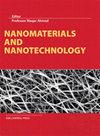碳纳米管在ZnO纳米颗粒表面缺陷钝化和紫外发射增强中的作用
IF 3.3
3区 材料科学
Q2 MATERIALS SCIENCE, MULTIDISCIPLINARY
引用次数: 6
摘要
我们报道了通过水热溶胶-凝胶途径合成的ZnO纳米颗粒的紫外发射的可控增强。在本研究中使用了各种表征技术来确定ZnO纳米颗粒的晶体结构、缺陷形成、形貌和尺寸。首先,通过x射线衍射对ZnO纳米粒子的结晶度进行了表征。通过透射电子显微镜和光致发光光谱分别研究了前驱体量对其形貌和带隙状态的影响。随后,用傅里叶变换红外光谱对杂质含量和相关键进行了表征。在这项工作中,ZnO纳米颗粒在可见光区域表现出明显的紫外发射和柔和的绿色发射。ZnO与碳纳米管(CNT)的结合抑制了可见光发射,并使紫外发射蓝移和增强了约5倍。这些结果表明碳纳米管可以有效地钝化ZnO纳米颗粒的表面状态。本文章由计算机程序翻译,如有差异,请以英文原文为准。
The role of CNT in surface defect passivation and UV emission intensification of ZnO nanoparticles
We report on the controlled enhancement of the UV emission from ZnO nanoparticles synthesized via hydrothermal sol-gel routes. Various characterization techniques were used in this study to determine the crystal structure, defect formation, morphology and size of the ZnO nanoparticles. Firstly, the crystallinity of the ZnO nanoparticles was assessed by X-ray diffraction. The role of the precursor quantities on their morphology and bandgap states was investigated via transmission electron microscopy and photoluminescence spectroscopy, respectively. Subsequently, the impurity content and related bonds were evaluated by Fourier-transform infrared spectroscopy. In this work, the ZnO nanoparticles manifest a sharp UV emission along with a subdued green emission in the visible region. Conjoining ZnO with carbon nanotubes (CNT) suppressed the visible emission, as well as blueshifted and intensified the UV emission by ∼5-fold. These results suggest that CNT are effective in passivating the surface states of ZnO nanoparticles.
求助全文
通过发布文献求助,成功后即可免费获取论文全文。
去求助
来源期刊

Nanomaterials and Nanotechnology
NANOSCIENCE & NANOTECHNOLOGY-MATERIALS SCIENCE, MULTIDISCIPLINARY
CiteScore
7.20
自引率
21.60%
发文量
13
审稿时长
15 weeks
期刊介绍:
Nanomaterials and Nanotechnology is a JCR ranked, peer-reviewed open access journal addressed to a cross-disciplinary readership including scientists, researchers and professionals in both academia and industry with an interest in nanoscience and nanotechnology. The scope comprises (but is not limited to) the fundamental aspects and applications of nanoscience and nanotechnology
 求助内容:
求助内容: 应助结果提醒方式:
应助结果提醒方式:


